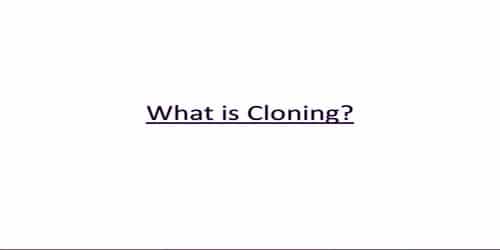A clone is a genetically identical copy of a gene and can either occur naturally or be created in the lab. Cloning is the process of producing genetically identical individuals to an organism, either naturally or artificially. As the Encyclopaedia Britannica explains, the definition of a clone comes from a cell or organism, an organism, which is “genetically identical to the original cell or organism” The word itself comes from the ancient Greek word “clone”, which means hesitation. Single-cell organisms, such as some yeast and bacteria, reproduce naturally occurring parental cells through emerging or binary fission. In biotechnology, cloning refers to the process of cloning an organism or producing a cell copy or DNA fragment (molecular cloning). The term biology refers to the production of multiple copies of digital media or software.
Cloning is commonly used to amplify whole-stranded DNA fragments, but it can be used to extend any DNA sequence such as promoters, non-coding sequences, and randomly fragmented DNA. It is used in a wide array of biological experiments and practical applications, ranging from genetic fingerprinting to large-scale protein production. In biomedical studies, cloning has been widely interpreted as a duplicate of any kind of biological material for scientific research, such as DNA or fragments of an individual cell. For example, parts of DNA are replicated instantly by a process known as polymerase chain reaction or PCR, a technology that is widely used in basic biological studies. There are three types of cloning: gene cloning, reproductive cloning, and treatment cloning. Gene cloning is essentially a recombinant DNA technology where a fragment of a foreign DNA is inserted into a vector that can be copied by a host cell.
Reproductive cloning was originally carried out by artificial ” twinning ” or embryo segmentation that German embryologist Hans Spemann performed on the first Salamander embryo in the early1900s. Later, Spammon, who was awarded the Nobel Prize for Physiology or Medicine for research on embryonic development (1935), was theorized about another cloning method known as nuclear transfer. Dolly is the first mammal that was brought into the world using SCNT in 1996. Wilmut and his team at the Roslin Institute in Scotland replaced the nucleus with a cell nucleus from a mammary gland of a six-year-old Finn Dorset lamb from an oocyte taken from a blackface ewe (this lamb has a white face). Japanese scientists have even announced an attempt to clone a furry giant. Woolly mammoths were extinct about 10,000 years ago. Global warming has caused meltdowns in eastern Russia’s permafrost region, and the remains of several well-preserved mammoths have recently been discovered. However, these findings are debatable where ethical positions must also be considered before fully embracing artificial cloning and being used throughout today’s society.
The cloning process can be used to repair or grow new cells to replace damaged or missing ones that can treat ailments and genetic disorders. Couples who were unable to conceive naturally were able to produce children through human cloning, and they had a pure genetic relative. The average lifetime for top countries in the developed world is approaching 85 years. Even in the United States, the average life expectancy for men and women is over 70 years. Not only can cloning help to prolong life, but it can also be a way to promote the world around the world. When we look at the success rate of animal cloning, a successful embryo is produced in about 1% of the best cases. Dolly the Shape may be a success story, but the inconvenience has made it illegal for many governments around the world to try this approach with human cells. Cloning is far from a perfect science. Many of the disadvantages involve the “What ifs” of this science, but there are some things to consider. There are potential health benefits, but there are also potential health risks.











